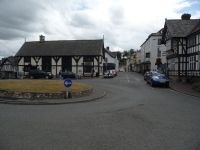Ruthin (/ˈrɪθɪn/ (listen) RITH-in; Welsh: Rhuthun) is a market town and community in Denbighshire, Wales, in the south of the Vale of Clwyd. It is the county town of Denbighshire. The town, castle and St Peter's Square lie on a hill. Ruthin is skirted by villages such as Pwllglas and Rhewl. The name comes from the Welsh rhudd (red) and din (fort), after the colour of the sandstone bedrock of which the castle was built in 1277–1284. The original name was Castell Coch yng Ngwern-for (Red Castle in the Sea Swamps). The Old Mill, Ruthin, is nearby. Maen Huail, a registered ancient monument attributed to the brother of Gildas and King Arthur, stands in St Peter's Square.
History
There is evidence of Celtic and later Roman settlements in the area. However, little is known of the history of the town before the construction of Ruthin Castle was started in 1277 by Dafydd, the brother of prince Llywelyn ap Gruffudd. However, he forfeited the castle when he rebelled against King Edward I with his brother; Edward's queen, Eleanor, was in residence in 1281. The Marcher Lord, Reginald de Grey, Justiciar of Chester, was given the Cantref (an administrative district) of Deffrencloyt (Dyffryn Clwyd, the Welsh for Vale of Clwyd), and his family ran the area for the next 226 years. The third Baron de Grey's land dispute with Owain Glyndwr triggered Glyndwr's rebellion against King Henry IV, which began on 16 September 1400, when Glyndwr burned Ruthin to the ground, reputedly leaving only the castle and a few other buildings standing.
The Lord de Grey established a Collegiate Church in 1310. Now the Collegiate and Parish Church of St Peter, it dominates the Ruthin skyline. It has a double nave and boasts two medieval carved roofs. These days it is known for its musical tradition. It has a large choir of children and adults and a four-manual Wadsworth-Willis organ. Behind the church can be seen the old college buildings, school and Christ's Hospital.
A Ruthin native, Sir Thomas Exmewe was Lor
